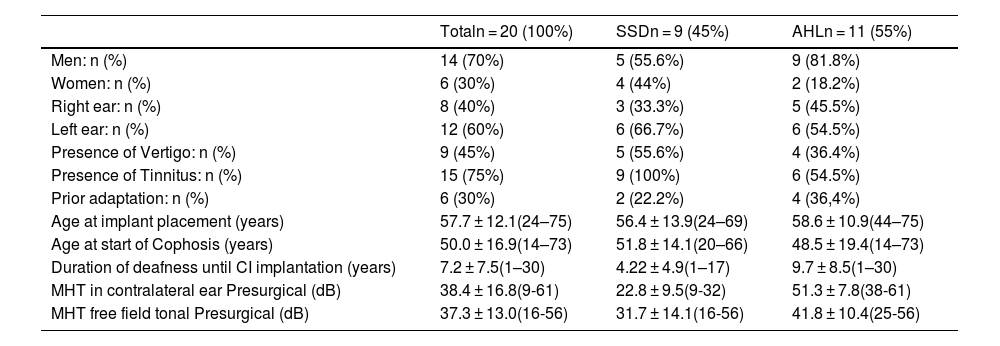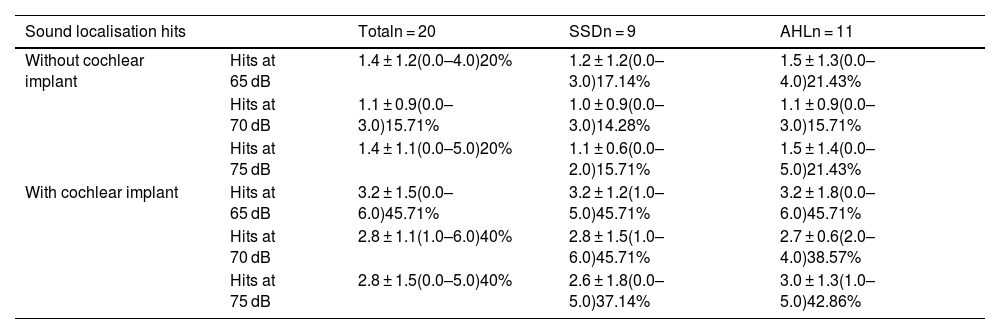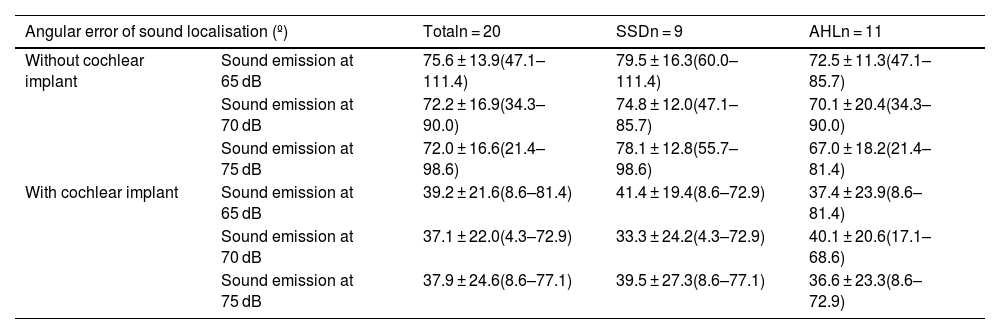Sound localization plays a crucial role in our daily lives, enabling us to recognize voices, respond to alarming situations, avoid dangers, and navigate towards specific signals. However, this ability is compromised in patients with Single-Sided Deafness (SSD) and Asymmetric Hearing Loss (AHL), negatively impacting their daily functioning. The main objective of the study was to quantify the degree of sound source localization in patients with single-sided deafness or asymmetric hearing loss using a Cochlear Implant (CI) and to compare between the two subgroups.
Materials and methodsThis was a prospective, longitudinal, observational, single-center study involving adult patients diagnosed with profound unilateral or asymmetric sensorineural hearing loss who underwent cochlear implantation. Sound localization was assessed in a chamber equipped with seven speakers evenly distributed from −90º to 90º. Stimuli were presented at 1000 Hz and intensities of 65 dB, 70 dB, and 75 dB. Each stimulus was presented only once per speaker, totaling 21 presentations. The number of correct responses at different intensities was recorded, and angular error in degrees was calculated to determine the mean angular distance between the patient-indicated speaker and the speaker presenting the stimulus. Both assessments were conducted preoperatively without a cochlear implant and two years post-implantation.
ResultsThe total sample comprised 20 patients, with 9 assigned to the SSD group and 11 to the AHL group. The Preoperative Pure Tone Average (PTA) in free field was 31.7 dB in the SSD group and 41.8 dB in the AHL group. There was a statistically significant improvement in sound localization ability and angular error with the use of the cochlear implant at all intensities in both SSD and AHL subgroups.
ConclusionsCochlear implantation in patients with SSD and AHL enhances sound localization, reducing mean angular error and increasing the number of correct sound localization responses.
La localización del sonido es de gran importancia en nuestro día a día ya que nos permite reconocer voces, alertarnos ante situaciones alarmantes, evitar peligros, dirigirnos hacia una determinada señal, etc. Sin embargo, esta capacidad está alterada en pacientes con Hipoacusia Unilateral (HU) e Hipoacusia Asimétrica (HA) lo que repercute negativamente en su día a día.
El objetivo principal del estudio fue cuantificar el grado de localización de la fuente sonora en pacientes con hipoacusia neurosensorial unilateral o asimétrica portadores de un implante coclear (IC) y comparar entre ambos subgrupos.
Material y métodosSe trata de un estudio unicéntrico descripitivo observacional longitudinal prospectivo de pacientes adultos diagnosticados de hipoacusia neurosensorial profunda unilateral o hipoacusia neurosensorial asimétrica que fueron implantados con un implante coclear. Se realizó un estudio de localización en una cabina con 7 altavoces distribuidos de forma equidistante desde −90º a 90º. Se emitieron estímulos a 1000 Hz y a una intensidad de 65 dB, 70 dB y 75 dB. Cada estímulo se presentó únicamente una vez por cada altavoz, realizando 21 presentaciones. Se determino el número de aciertos alcanzados en cada presentación a las diferentes intensidades y se calculó el error angular en grados para determinar la distancia angular media entre el altavoz indicado por el paciente y el altavoz por el que se presentaba el estímulo. Ambas determinaciones se realizaron prequirúrgicamente sin implante coclear y a los dos años de la cirugía con implante coclear.
ResultadosEl total de la muestra fue de 20 pacientes de los cuales 9 fueron asignados al grupo HU y 11 al grupo HA. La Umbral Auditivo Medio (UAM) en campo libre prequirúrgico fue de 31,7 dB en el grupo de HU y de 41,8 dB en el grupo de HA.
Hubo una mejoría tanto de la capacidad de localización del sonido como del error angular de localización del sonido con el uso del implante coclear de forma estadísticamente significativa en todas las intensidades y en ambos subgrupos (HU e HA).
ConclusionesEl IC en pacientes con HU e HA mejora la localización del sonido con una reducción del error angular medio y un aumento del número de aciertos de localización del sonido.












